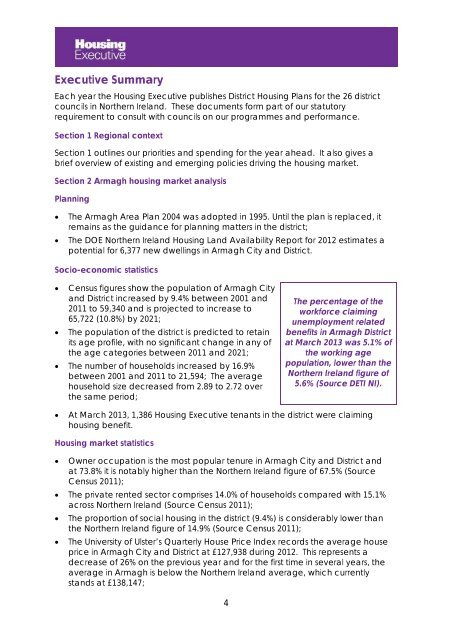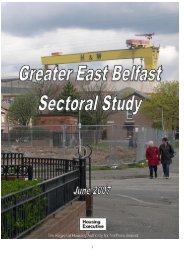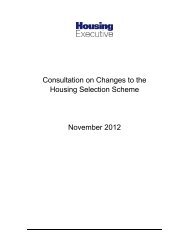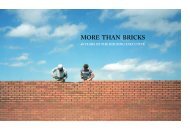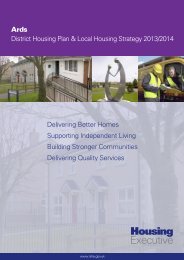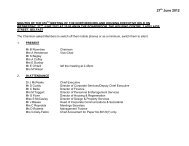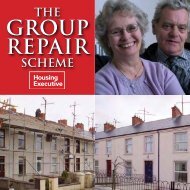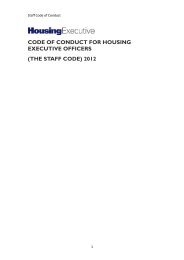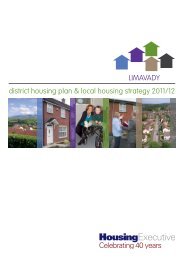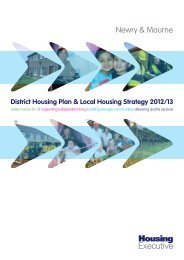Armagh - Northern Ireland Housing Executive
Armagh - Northern Ireland Housing Executive
Armagh - Northern Ireland Housing Executive
Create successful ePaper yourself
Turn your PDF publications into a flip-book with our unique Google optimized e-Paper software.
<strong>Executive</strong> Summary<br />
Each year the <strong>Housing</strong> <strong>Executive</strong> publishes District <strong>Housing</strong> Plans for the 26 district<br />
councils in <strong>Northern</strong> <strong>Ireland</strong>. These documents form part of our statutory<br />
requirement to consult with councils on our programmes and performance.<br />
Section 1 Regional context<br />
Section 1 outlines our priorities and spending for the year ahead. It also gives a<br />
brief overview of existing and emerging policies driving the housing market.<br />
Section 2 <strong>Armagh</strong> housing market analysis<br />
Planning<br />
• The <strong>Armagh</strong> Area Plan 2004 was adopted in 1995. Until the plan is replaced, it<br />
remains as the guidance for planning matters in the district;<br />
• The DOE <strong>Northern</strong> <strong>Ireland</strong> <strong>Housing</strong> Land Availability Report for 2012 estimates a<br />
potential for 6,377 new dwellings in <strong>Armagh</strong> City and District.<br />
Socio-economic statistics<br />
• Census figures show the population of <strong>Armagh</strong> City<br />
and District increased by 9.4% between 2001 and The percentage of the<br />
2011 to 59,340 and is projected to increase to workforce claiming<br />
65,722 (10.8%) by 2021; unemployment related<br />
• The population of the district is predicted to retain benefits in <strong>Armagh</strong> District<br />
its age profile, with no significant change in any of at March 2013 was 5.1% of<br />
the age categories between 2011 and 2021;<br />
the working age<br />
• The number of households increased by 16.9% population, lower than the<br />
between 2001 and 2011 to 21,594; The average <strong>Northern</strong> <strong>Ireland</strong> figure of<br />
household size decreased from 2.89 to 2.72 over 5.6% (Source DETI NI).<br />
the same period;<br />
• At March 2013, 1,386 <strong>Housing</strong> <strong>Executive</strong> tenants in the district were claiming<br />
housing benefit.<br />
<strong>Housing</strong> market statistics<br />
• Owner occupation is the most popular tenure in <strong>Armagh</strong> City and District and<br />
at 73.8% it is notably higher than the <strong>Northern</strong> <strong>Ireland</strong> figure of 67.5% (Source<br />
Census 2011);<br />
• The private rented sector comprises 14.0% of households compared with 15.1%<br />
across <strong>Northern</strong> <strong>Ireland</strong> (Source Census 2011);<br />
• The proportion of social housing in the district (9.4%) is considerably lower than<br />
the <strong>Northern</strong> <strong>Ireland</strong> figure of 14.9% (Source Census 2011);<br />
• The University of Ulster’s Quarterly House Price Index records the average house<br />
price in <strong>Armagh</strong> City and District at £127,938 during 2012. This represents a<br />
decrease of 26% on the previous year and for the first time in several years, the<br />
average in <strong>Armagh</strong> is below the <strong>Northern</strong> <strong>Ireland</strong> average, which currently<br />
stands at £138,147;<br />
4


